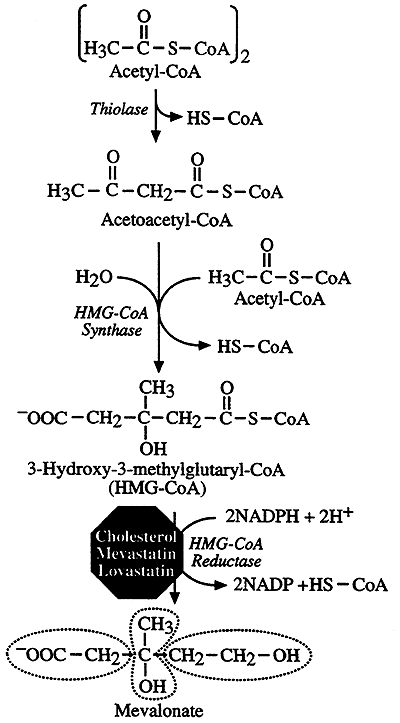
Cholesterol
1. Present in tissues as either free cholesterol or cholesterol ester.
2. Synthesized in many tissues from acetyl CoA.
(a) 75% of the cholesterol in the body is synthesized, only 25% comes from the diet
(b) major sites of synthesis are liver, intestine, skin and endocrine glands
Synthesis of Mevalonate from Acetyl CoA: Acetyl CoA is produced primarily from b-oxidation of fatty acids.

HMG-CoA Reductase is induced by low cholesterol and regulates the entire pathway.
Synthesis of Squalene from Mevalonate:
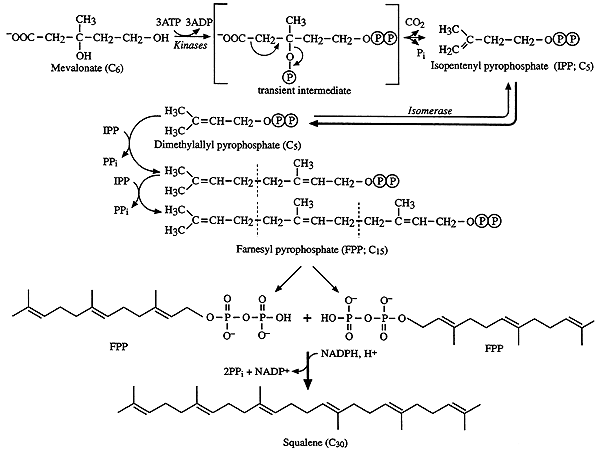
Synthesis of Cholesterol from Squalene:
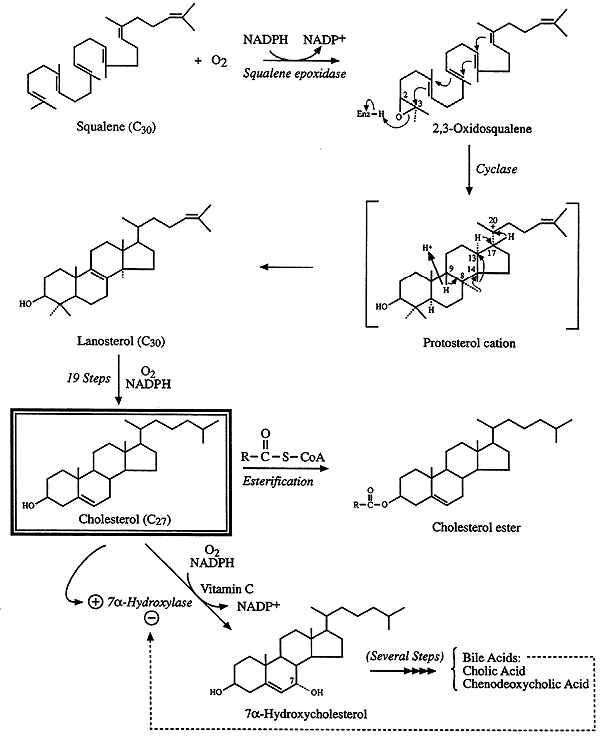
Note: The enzyme that catalyzes "Esterification" of cholesterol is ACAT. 7a-Hydroxylase is activated by XS Cholesterol and inhibited by XS Bile Acid.
3. Ultimately eliminated from the body as cholesterol in bile acids.
4. Cholesterol is the precursor of ALL other steroids in the body, i.e. corticosteroids, sex hormones, vitamin D, bile acids.
5. Occurs in foods of animal origin, i.e. egg yolk, meat and liver.
6. Cholesterol is an amphiphilic lipid ----> essential structural component of membranes.
7. Lipoproteins transport cholesterol esters in their hydrophobic core.
Low Density Lipoprotein (LDL) mediates cholesterol up-take into tissues. (BAD chol.)
High Density Lipoprotein (HDL) removes cholesterol from the tissues to the liver where it is transformed to bile acids and eliminated. (GOOD Chol.)
8. Cholesterol is the major contributor to atherosclerosis (blocking and hardening of the arteries) caused by deposits of LDL (cholesterol) on artery walls.
Coronary atherosclerosis correlates with a high plasma LDL:HDL cholesterol ratio.
9. Cholesterol Balance in Tissues: Steps 1, 2, 3, 4, 5 add to the cholesterol "pool"; a, b, and c remove cholesterol.
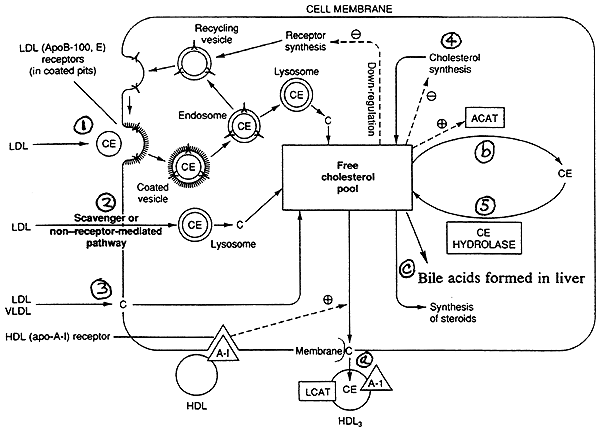
When the Body Needs to Increase in Cholesterol
(a)up-take of cholesterol containing lipoproteins by receptors, i.e. LDL receptor.
(b)up-take of cholesterol containing lipoproteins by a non-receptor mediated pathway.
(c)up-take of free cholesterol from cholesterol rich lipoproteins to the cell membrane.
(d)cholesterol synthesis.
Via HMG-CoA Reductase and LDL Receptor Induction:
(e)hydrolysis of cholesterol esters.
When the Body Needs to Decrease in Cholesterol:
(a)efflux of cholesterol to HDL, promoted by LCAT.
(b)HDL's cleared by the liver as bile acids.
(c)esterification of cholesterol for storage by ACAT.
(d)utilization of cholesterol for synthesis of other steroids such as hormones.
Dietary Measures:
Low cholesterol.
High mono- and polyunsaturated fats (sunflower, canola, corn, soybean, olive).
Low saturated fats (butter, beef, palm).
Cholesterol Lowering Drugs:
| Drug | Indications |
Primary Effect |
| Cholestyramine | High LDL | Binds bile acids (Bile Acid Sequestrant) |
|
Lovastatin Mevastatin |
High LDL | Competitive Inhibition of HMG-CoA Reductase |
| Clofibrate |
Low HDL |
Diverts free fatty acids from esterification |
| Gemfibrozil | High LDL | Decreases the secretion of choles. cont. LDL |
| Probucol | Familial Hypercholesterolemia | Decreases accumulation of LDL in arteries |
| Niacin | Low HDL and High LDL |
Decreases flux of free fatty acids for b-oxidation Decreases the secretion of choles. cont. LDL |
Summary of Cholesterol Metabolism:
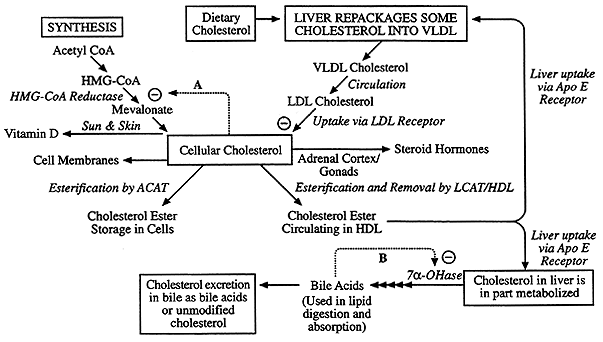
© Dr. Noel Sturm 2015